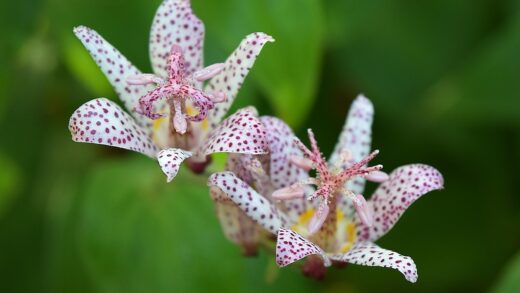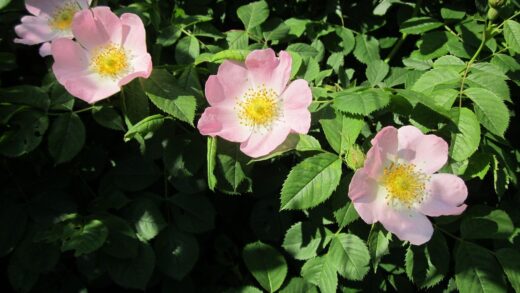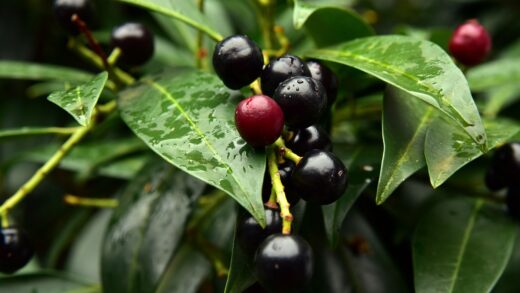Even with the most diligent care, bean crops can fall prey to a variety of diseases and pests that can compromise plant health and significantly reduce yields. Successful management of these threats relies on a proactive and integrated approach, combining preventative cultural practices with the ability to accurately identify and respond to problems as they arise. From fungal pathogens that thrive in humid conditions to insects that feed on leaves and pods, understanding the life cycles and habits of these adversaries is the first step. By employing strategies that range from crop rotation and proper spacing to the use of biological controls and targeted treatments, growers can protect their harvest and ensure the long-term health of their garden ecosystem.
Fungal diseases are among the most common afflictions of bean plants, particularly in regions with high humidity or during periods of frequent rainfall. One prevalent issue is powdery mildew, which appears as a white, powdery coating on the surface of leaves, stems, and sometimes pods. While it may not kill the plant outright, a severe infection can interfere with photosynthesis, stressing the plant and reducing its yield. Another common fungal problem is bean rust, which manifests as small, reddish-brown pustules on the undersides of the leaves. These pustules contain spores that can spread rapidly, causing leaves to yellow and drop prematurely.
Other significant fungal diseases include white mold (Sclerotinia sclerotiorum) and anthracnose. White mold is particularly destructive, causing a watery rot at the base of the stem, followed by the growth of a white, cottony mycelium. It thrives in dense, moist plant canopies. Anthracnose causes dark, sunken spots on pods, stems, and leaves, which can make the pods inedible. The prevention of these diseases hinges on cultural practices that promote good air circulation, such as proper plant spacing, providing support for pole beans, and avoiding overhead watering, which wets the foliage.
Bacterial diseases also pose a serious threat to bean cultivation. Bacterial blights, including common blight and halo blight, are particularly widespread. Common blight causes large, irregular, water-soaked spots on leaves, which eventually dry out and turn brown, often with a thin yellow border. Halo blight is similar but is characterized by smaller spots that have a distinct, broad, yellow-green “halo” around them. These diseases are often introduced on infected seed and are easily spread by splashing rain, wind, and by working among wet plants.
To manage these fungal and bacterial threats, a preventative approach is most effective. Start by planting certified disease-free seed, and choose disease-resistant varieties whenever possible. Practice crop rotation, avoiding planting beans or other legumes in the same location for at least two to three years, as the pathogens can survive in the soil and on crop debris. At the end of the season, remove and destroy all plant residues to reduce the amount of inoculum that can overwinter. If a disease does take hold, applications of appropriate fungicides or bactericides may be necessary, with organic options like copper-based sprays or biofungicides often being effective if applied early.
More articles on this topic
Common insect pests
A variety of insect pests are attracted to bean plants, and they can cause damage by feeding on leaves, stems, pods, and roots. One of the most notorious is the Mexican bean beetle, which resembles a large, copper-colored ladybug but is a destructive pest. Both the adult beetles and their spiny, yellow larvae feed voraciously on the undersides of bean leaves, skeletonizing them by eating the tissue between the veins, which gives the leaves a lace-like appearance. A heavy infestation can defoliate and kill entire plants.
Aphids are another common nuisance. These small, soft-bodied insects typically congregate in clusters on the undersides of leaves and on tender new growth. They feed by piercing the plant tissue and sucking out the sap, which can cause leaves to curl, yellow, and become distorted. As they feed, aphids also excrete a sticky substance called honeydew, which can lead to the growth of sooty mold. Furthermore, aphids are significant vectors for transmitting viral diseases from one plant to another.
Other chewing insects that can damage beans include various types of caterpillars, such as the corn earworm, which will also feed on bean pods, boring holes and damaging the developing seeds inside. Spider mites, which are not insects but arachnids, can also be a problem, especially in hot, dry weather. They are tiny and difficult to see but create a fine webbing on the plant and cause a stippled, speckled appearance on the leaves as they feed. In some areas, leafhoppers can also be prevalent, causing a condition known as “hopperburn,” where the leaf tips turn yellow and brown.
Managing these insect pests effectively requires regular monitoring and early intervention. Handpicking larger pests like Mexican bean beetles and their larvae and dropping them into a bucket of soapy water can be an effective control method in small gardens. A strong spray of water from a hose can dislodge aphids and spider mites. For more severe infestations, insecticidal soaps or horticultural oils can be used, which are effective against soft-bodied insects and have a lower impact on beneficial predators. Introducing or encouraging beneficial insects, such as ladybugs, lacewings, and parasitic wasps, which prey on these pests, is a cornerstone of an integrated pest management approach.
Viral diseases and their vectors
Viral diseases can be particularly challenging to manage in beans because there are no chemical cures once a plant is infected. These diseases are caused by microscopic pathogens that replicate inside the plant’s cells, disrupting normal growth and development. One of the most common is the Bean Common Mosaic Virus (BCMV). Symptoms can vary but often include a mosaic or mottled pattern of light and dark green on the leaves, leaf puckering and distortion, and overall stunting of the plant. The virus is often seed-borne, meaning it can be present within the seed itself.
Another important viral disease is the Bean Yellow Mosaic Virus (BYMV). As its name suggests, it typically causes bright yellow mottling or spotting on the leaves, though symptoms can be variable. Both BCMV and BYMV can significantly reduce the vigor and yield of infected plants. The viruses are systemic, meaning they spread throughout the entire plant, and once a plant is infected, it remains a source of the virus for the rest of the season.
The primary way that these viruses spread from an infected plant to a healthy one is through insect vectors, most notably aphids. As an aphid feeds on the sap of an infected plant, it picks up virus particles on its piercing-sucking mouthparts. When it moves to a healthy plant to feed, it transmits the virus. This transmission can happen very quickly, in a matter of seconds, which makes controlling the spread difficult. Even a small number of aphids can cause a widespread infection throughout a bean patch.
Because there is no cure for viral diseases, management must focus entirely on prevention. The single most effective strategy is to plant certified virus-free seed from a reputable source. Many modern bean varieties have been bred for resistance to specific viruses, particularly BCMV, and selecting these resistant cultivars is highly recommended. The second key strategy is to control the aphid populations that act as vectors. Encouraging beneficial insects that prey on aphids, avoiding the overuse of nitrogen fertilizer (which can promote the soft, succulent growth that aphids prefer), and using insecticidal soap sprays at the first sign of an infestation can all help to reduce the spread of these damaging diseases.
Integrated pest management strategies
Integrated Pest Management (IPM) is a holistic and sustainable approach to managing pests and diseases that combines multiple strategies to minimize economic damage and environmental impact. Rather than relying on a single tactic, such as routine chemical spraying, IPM uses a deep understanding of the pest and disease life cycles to implement a hierarchy of controls. The foundation of any IPM program is prevention. This includes cultural practices like crop rotation, which breaks the life cycle of soil-borne pathogens and pests, and proper sanitation, such as removing crop debris at the end of the season to eliminate overwintering sites.
Another key component of IPM is monitoring and scouting. This involves regularly inspecting the bean plants to identify and quantify any pest or disease presence. This allows for early detection when populations are low and easier to manage. Using tools like yellow sticky traps can help to monitor for flying insect pests. By keeping records of pest and disease observations from year to year, a gardener can anticipate potential problems and be better prepared. Action thresholds are then used to determine when intervention is actually necessary, rather than treating preventatively without cause.
When control is deemed necessary, IPM prioritizes the use of the least disruptive methods first. This can include mechanical or physical controls, such as handpicking Mexican bean beetles, using floating row covers to create a physical barrier against insects on young plants, or using a strong jet of water to wash off aphids. Biological control is another crucial element, which involves conserving and encouraging the populations of natural enemies—the predators, parasitoids, and pathogens that attack pests. This can be achieved by planting a diversity of flowering plants that provide nectar and pollen for these beneficial insects.
Chemical controls, especially synthetic pesticides, are used only as a last resort in an IPM framework. When they are necessary, the most selective and least toxic options are chosen, such as insecticidal soaps or neem oil, which have a lower impact on beneficial insects and the environment. The timing and application of these products are done carefully to maximize their effectiveness against the target pest while minimizing harm to non-target organisms. This intelligent, multi-faceted approach to pest and disease management leads to healthier plants, a healthier environment, and a more sustainable gardening system.
Soil health and disease prevention
The health of the soil is inextricably linked to the health of the plants growing in it, and it plays a fundamental role in disease prevention. A biologically active soil with a diverse population of microorganisms can help to suppress soil-borne pathogens. Many beneficial fungi and bacteria outcompete pathogenic organisms for resources or produce compounds that are antagonistic to them. Building and maintaining healthy soil is, therefore, one of the most effective long-term strategies for preventing many root rots and other soil-borne diseases that can affect beans.
The cornerstone of building healthy soil is the regular addition of organic matter. Incorporating materials like compost, leaf mold, and well-rotted manure improves soil structure, aeration, and drainage. Good drainage is particularly critical for preventing root rot diseases, as the fungal pathogens that cause them, such as Pythium and Rhizoctonia, thrive in waterlogged, anaerobic conditions. Soil with a high content of organic matter acts like a sponge, holding moisture but also maintaining pore spaces for air, creating an environment where plant roots and beneficial microbes can flourish.
Maintaining an appropriate soil pH is also crucial for both plant health and disease suppression. As previously discussed, beans prefer a pH between 6.0 and 7.0. In this range, the availability of essential nutrients is optimized, leading to strong, vigorous plants that are inherently more resistant to disease. An imbalanced pH can stress the plant and make it more susceptible to infection. Furthermore, the activity of certain soil-borne pathogens can be influenced by pH. For example, some diseases are more prevalent in highly acidic or alkaline soils.
Finally, avoiding soil compaction is important for overall root health. Compacted soil has poor aeration and drainage and can physically impede root growth. Healthy roots are essential for water and nutrient uptake and are the plant’s first line of defense. Avoid walking on garden beds, especially when the soil is wet, and till or dig only when necessary. By focusing on creating a fertile, well-drained, and biologically active soil, a gardener is not just feeding the plants but is cultivating a resilient ecosystem that can naturally help to defend the bean crop against disease.




















